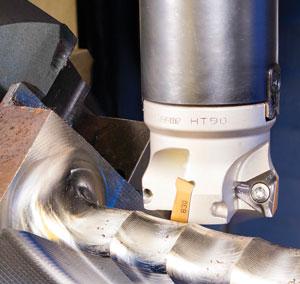- FMA
- The Fabricator
- FABTECH
- Canadian Metalworking
Multitasking to Increase Your Efficiency
Productive machining using mill/turn methods demands proper cutter positioning
- By Andrei Petrilin
- January 20, 2014
- Article
- Metalworking

Modern multitasking machine tools now feature additional axes of head movement, advanced control systems, and upgraded software that allow these systems to perform the majority of machining operations with only one setting per workpiece.
In a multitasking operation, a milling cutter can machine a rotating workpiece. Combining milling and turning techniques has many advantages, but only relatively recently have multitasking machine tools allowed this process to display its full benefits.
Introducing multitasking in the manufacturing process can solve quality problems and substantially improve output. And highly productive machining using this method is possible with modern machines and correctly chosen cutting tools are used.
For years, even with mass adoption of CNC technology, development of metal cutting machine tools has been done in a very traditional manner. Machining centers integrate rotating tools, both milling and drilling, while CNC lathes are developed to handle turning tasks. Looking for new ways to make the manufacturing process more efficient by reducing setups of a machined part and eliminating the part’s transfer from one machine to another led to addition of a tool head with a rotary drive to typical CNC turning machines, thereby enabling turn/milling.
Modern multitasking machine tools now feature additional axes of head movement, advanced control systems, and upgraded software that allow these systems to perform the majority of machining operations with only one setting per workpiece.
Types of Multitasking
A multitasking operation employes two principal kinds of machining: peripheral, in which the axes of the workpiece and the cutter are parallel, and face, in which these axes cross.
Peripheral multitasking is similar to milling by helical interpolation and may apply both to external and internal surfaces of the revolution; while, with the use of face multitasking only, the external surfaces can be machined.
Even though multitasking seems to be similar to turning by a rotating mill, there is a substantial difference between these two machining processes. The cutting speed in multitasking is defined by the peripheral speed of the milling cutter, not by the rotary velocity of the workpiece like in turning. The workpiece rotation relates to feed.
Multitasking is practical in many situations, including the following:
1. The machining of noncontinuous surfaces, which may cause interrupted cutting, such as various grooves and undercuts. In classical turning, this operation results in unwanted impact load, poor surface finish, and early tool wear. In multitasking, the tool is a milling cutter that is intended exactly for interrupted cuts with cyclic load.
2. The machining of materials that produce long chips. In turning, chip disposal can be difficult, and finding the proper chip-breaking geometry for a cutting tool is not a simple task. The milling cutter used in multitasking generates a short chip that considerably improves swarf handling.

Multitasking is suitable for machining an eccentric shaft because it produces a low rotary velocity.
3. The eccentric machining of rotating components such as crankshafts and camshafts. In traditional turning, the off-center masses of these components (crank journal, eccentric cam) cause unbalanced forces that adversely affect performance. Multitasking, which uses low rotary velocity of the workpiece, will help to prevent this negative effect.
4. The machining of heavy parts. The rotation of heavy parts, which defines cutting speed in traditional turning, is based on the limitations of the main drive of the machine tool. If the drive does not allow rotation of large masses with the required velocity, cutting speed is far from the optimal range, and turning performance will be low. Multitasking provides a way to overcome these difficulties effectively.
Selecting Tooling
The questions regarding multitasking application, tool choice, and cutting data deserve careful consideration and should be examined individually.
Indexable face milling cutters are good tools for multitasking. However, productive machining with this method also demands proper cutter positioning with respect to the workpiece, and the correct choice of insert geometry and tool path.
Cutter positioning, for instance, influences form errors, and insert geometry influences surface finish. Usually the final shape is produced by a wiper insert, which is mounted on the cutter.
Related Companies
subscribe now


Keep up to date with the latest news, events, and technology for all things metal from our pair of monthly magazines written specifically for Canadian manufacturers!
Start Your Free Subscription- Trending Articles
- Industry Events
MME Winnipeg
- April 30, 2024
- Winnipeg, ON Canada
CTMA Economic Uncertainty: Helping You Navigate Windsor Seminar
- April 30, 2024
- Windsor, ON Canada
CTMA Economic Uncertainty: Helping You Navigate Kitchener Seminar
- May 2, 2024
- Kitchener, ON Canada
Automate 2024
- May 6 - 9, 2024
- Chicago, IL
ANCA Open House
- May 7 - 8, 2024
- Wixom, MI














